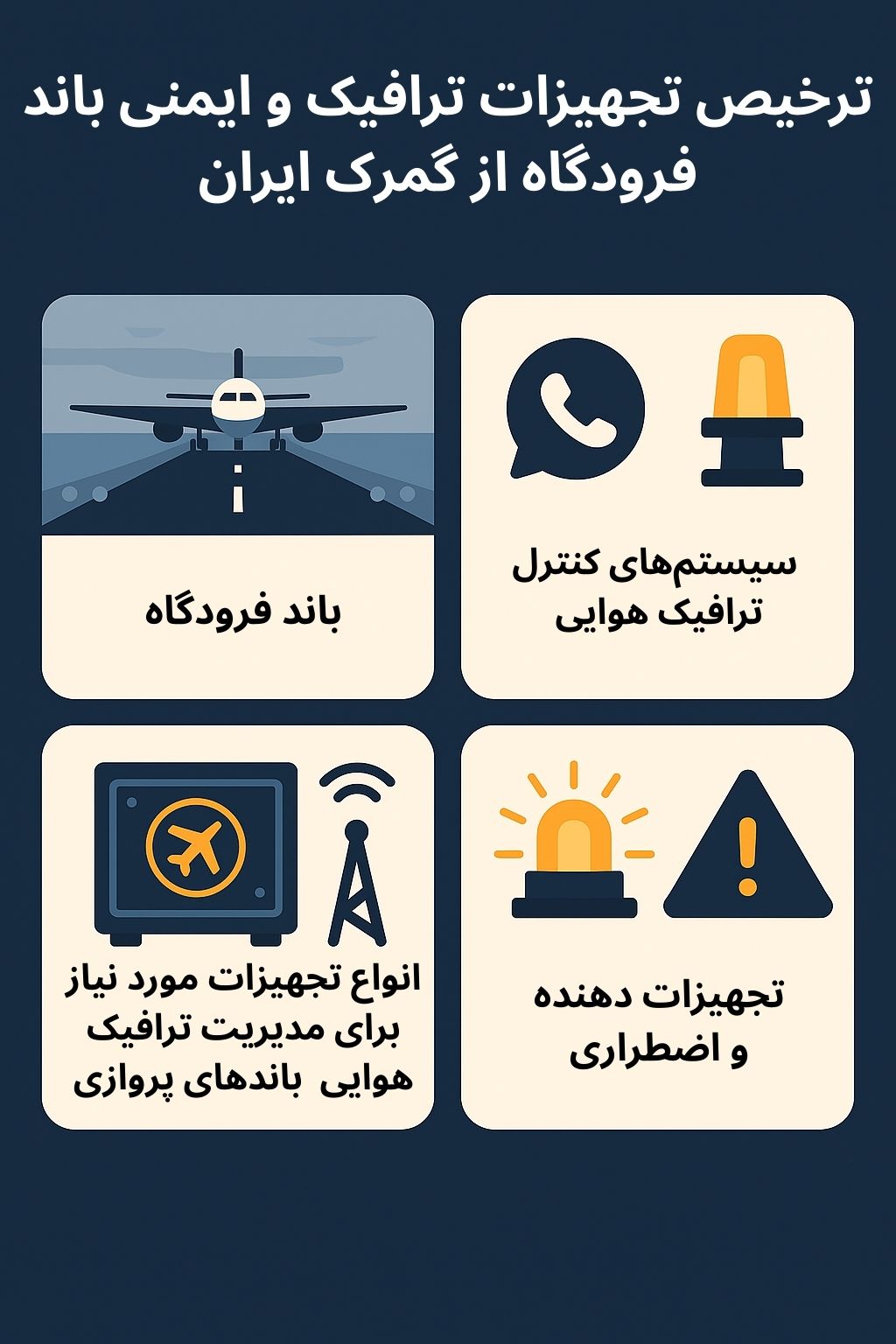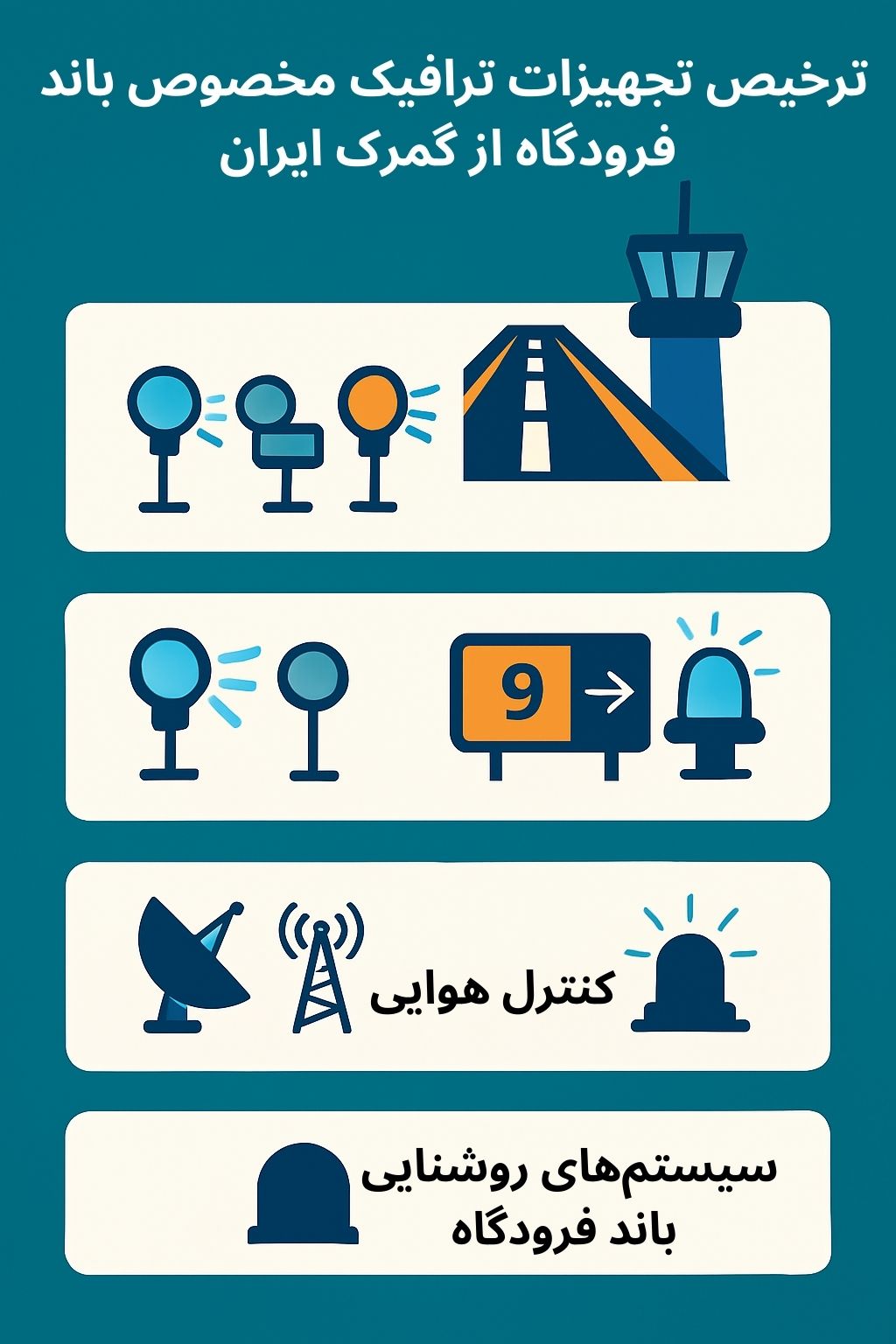Customs Clearance of Airport Runway Traffic Control Equipment (HS Code + Documents and Permits)
Clearing electrical safety and airport runway traffic control equipment is considered one of the most important and specialized processes in the field of clearing imported goods. Due to their role in maintaining flight safety and managing air traffic on airport runways, these devices are of great importance. The import and clearance process for this equipment requires precision and compliance with laws and regulations aligned with national and international standards.
To estimate the time and cost of clearing electrical safety and airport runway traffic control equipment, contact Saba Tarkhis experts.
Instant Free Consultation
1) Detailed Description of Electrical Safety and Runway Traffic Control Equipment
Airport runway lighting systems
Runway edge lights: These lights are installed along the runway edges and show pilots the exact path of the runway. Edge lights are installed in different colors depending on position (such as blue, white, or red) and help pilots identify runway boundaries.
Runway entry and exit lights: These lights are installed at the runway entry and exit points and indicate the path into and out of the runway for aircraft. These lights are typically green and red.
Runway centerline lights: These lights are installed along the centerline and help aircraft follow the exact runway path, especially at night or in low-visibility conditions.
Runway end lights: These are installed at the end of the runway and indicate its end. They are marked in red and inform pilots that the runway has ended.
Runway marker lighting equipment:
Runway guidance signs: These signs provide key information such as runway numbers, direction, and alternate routes to pilots. They are especially important at night or when visibility is limited.
Position indicator lights: These lights are placed near guidance signs and illuminate simultaneously to draw pilots’ attention to important information shown on the signs.
Air traffic control systems:
Air traffic control radars: These radars monitor aircraft positions within the airport airspace and coordinate their movements. They are vital tools for preventing collisions and properly managing traffic within airport airspace.
Communications equipment: This includes communication devices such as radios and digital transmitters that enable effective communication between air traffic controllers and pilots. They allow controllers to issue necessary instructions quickly and accurately.
Intelligent control software: Advanced air traffic control software automatically manages air traffic and, by analyzing input from radars and other sensors, determines optimal routes and times for takeoff and landing.
Warning and emergency equipment:
Alarm sirens: These sirens sound during emergency conditions on the runway to alert staff and pilots. They may operate acoustically or visually and quickly attract attention.
Emergency flashing lights: Specifically designed to announce emergencies on the runway, typically installed at strategic points and flashing continuously to warn pilots and staff.
Emergency information and communication systems: These enable rapid, direct communication between pilots, controllers, and rescue teams, helping speed up responses during critical situations.
2) Types of Equipment and Practical Applications
- Runway/Taxiway/Approach lighting: Path guidance; improved night and low-visibility conditions.
- Airfield signs: Runway numbers, taxiway routes, and restrictions.
- Radar and navigation systems (ATS/ATM): Traffic monitoring, collision avoidance, and landing/takeoff sequencing.
- Aviation communication networks (VHF/UHF/VoIP): Reliable links between control tower and pilots.
- Emergency warning systems: Visual/audio alerts for critical conditions in firefighting, movement areas, and maneuvering surfaces.
3) Key Clearance Points and Legal Requirements
Importance of clearing electrical airport safety and traffic control equipment
Due to their critical role in airport safety and operational efficiency, these devices must undergo thorough technical and quality inspections before entry to ensure compliance with required standards. Imported equipment should also hold necessary certifications from reputable international bodies such as ICAO and FAA.
Key points in clearing electrical airport safety and traffic control equipment
Clearance is a complex, multi-faceted process requiring strict adherence to numerous international and national standards. Given their vital role in managing air traffic and flight safety, the following technical points are essential:
1. Compliance with international standards
Electrical airport safety and traffic control equipment must comply with stringent international standards such as ICAO and FAA.
ICAO standards: Focused on safety, efficiency, and reliability of aviation equipment, including design, installation, maintenance, and operation of runway lighting, navigation systems, and other ATC tools.
FAA standards: Provide detailed technical regulations for aviation-related equipment covering design, manufacturing, and operation. All imported equipment must hold the required certifications to be permitted entry.
2. Determining and applying the HS Code
One of the most important steps is accurately determining the HS Code, which dictates classification and applicable duties.
HS Code 8539: For example, runway lighting lamps are often classified under 8539, which covers electric lamps and lighting equipment. This impacts both classification and the duties/taxes payable.
Importance of accuracy: Misclassification can lead to incorrect tariff application, over/under payment of duties, and even legal issues. Thorough knowledge of related HS Codes for each equipment type is essential.
3. Obtaining import permits and technical approvals
Importing these devices without proper permits is not possible.
Civil Aviation Organization (CAO) permits: As Iran’s main supervisory body, it issues the necessary import permits. These should include technical approvals proving compliance with international and national standards.
Iran National Standards Organization (INSO) permits: Responsible for assessing quality and safety of imported equipment. Issued certificates confirm compliance with domestic standards.
Compatibility assessment: All imported equipment must be checked for conformity with national conditions and regulations through technical, performance, and safety tests by approved bodies.
4. Pre-shipment inspections (PSI)
Given sensitivity and safety requirements, some items require specialized PSI and testing by reputable international firms under relevant authorities’ oversight.
Performance tests: Verify precise operation under various conditions to ensure conformity with specified standards.
Safety tests: Ensure absence of potential hazards during use, including electrical, mechanical, and simulated emergency checks.
Standards conformity: Equipment must fully demonstrate compliance with international and national standards; any deficiency may lead to rejection or required modifications before clearance.
4) Customs Tariff (HS Code) for Selected Equipment
| Equipment Title | Short Description | HS Code (sample) |
|---|---|---|
| Runway/Taxiway lighting systems | Visual guidance and aerodrome traffic signage | 8530 (traffic signaling/safety equipment used at airports) |
| Aviation-specific lamps/LEDs | Lamps and light sources | 8539 (various lamps and lights) |
| Runway guidance signs | Illuminated/reflective aircraft guidance signs | 8530 (electric traffic signaling) |
| ATC radars/air traffic surveillance systems | Radar and radio-navigation equipment | 8526 (radar/radio navigation) |
| Aviation transceivers | VHF/UHF radios, VoIP | 8525 (radio transmission/broadcast equipment) |
Final classification depends on technical specs, integration level with airport systems, light source type, IP/IK grade, power supply, and place of use. The final HS line is determined after reviewing the datasheet and catalog.
Need precise HS Code determination, permits, and document preparation? Our team manages your case end to end.
Submit Proforma Request5) Special Import and Export Conditions
Import and export of electrical airport safety and traffic control equipment
Imports to Iran mainly come from advanced countries such as the United States, Germany, the United Kingdom, and Japan. These producers are recognized globally, and their products are approved by international organizations like ICAO and FAA due to high quality and precision.
Exporting countries: The U.S., Germany, and the U.K. are known for advanced technology and adherence to international standards, holding a significant share of the global market with modern equipment.
Exports from Iran are uncommon: Given the advanced technology and major investment required, developing countries—including Iran—are mainly importers; exports from Iran are less common.
6) Iranian Market and Supply Channels
- Common suppliers: United States, Germany, United Kingdom, Japan; also China and South Korea for some subsystems and spare parts.
- Potential export destinations for Iran (if domestically produced): Neighboring and regional countries with airport development projects.
- Key import points: Authenticating technical certificates, matching local voltage/frequency, and ensuring after-sales service guarantees.
7) Trade Volume and Demand Estimate
Import and export volumes
Import volumes depend on airport infrastructure needs and development plans. In recent years—given rising flights and development projects—demand has increased. Although exact figures are unavailable, imports remain significant.
8) Global Market and Key Players
- Leading manufacturers: USA, Germany, UK, Japan; growing supply from China and Europe in LEDs/controllers.
- Trends: Transition to high-efficiency LEDs, remote monitoring, integration with ATM/ATS systems.
- Compliance requirements: ICAO Annexes and FAA/EASA technical documents for safe operation.

9) Required Documents for Clearance
- Proforma/Invoice, packing list, bill of lading, certificate of origin.
- Catalog/datasheet, certificate of conformity (ICAO/FAA/EASA) if available, PSI report for sensitive items.
- Civil Aviation Organization permit, Iran National Standards permit (as applicable), after-sales/warranty letter.
10) Fast Clearance Method + Saba Tarkhis Special Services
- File preparation: HS Code matching, obtaining sectoral permits, collecting shipping and technical documents.
- Order registration and declaration: Entering exact technical specs per catalog; attaching certificates.
- Specialized controls: Standards/safety evaluation; site inspections if required.
- Payment of duties and taxes: Applying potential project/airport exemptions if eligible.
- Delivery and special transport: Safe packing; door-to-airport-site delivery with required coordination.
Frequently Asked Questions
Which HS Code fits runway lighting and signs?
For example, airport-use signaling/safety equipment is under 8530, and various lamps under 8539. Radars are typically 8526 and aviation radios 8525. Final determination follows a datasheet review.
Which permits are required for import?
Permit from the Civil Aviation Organization (technical/operational approval) and, as applicable, permits from the Iran National Standards Organization and safety inspection/test reports. For sensitive items, ICAO/FAA compliance certificates are recommended.
What should be considered for packing and transport?
Use impact/moisture-resistant boxes, fragile labeling, ESD control for electronics, and secure containers. For radar/radio units, anti-vibration packing and full insurance are advised.
Key Points and Practical Recommendations
- Always attach the manufacturer’s official datasheet to the declaration; classification and exemptions depend on it.
- For airport projects, ensure ICAO/FAA standards are matched to Iran’s operating conditions in advance.
- For consumable spares (lamps/LEDs), define a periodic supply plan to avoid operational downtime.
Special Airport Equipment Clearance Services by Saba Brokerage
With years of experience in customs clearance and a special focus on electrical airport safety and traffic control equipment, our brokerage provides comprehensive services, including:
- Specialized import consulting: Our expert team, fully aware of the latest customs regulations and international standards, advises you through all import stages.
- Obtaining permits and approvals: We secure all required national and international approvals for airport safety equipment, including CAO and INSO permits.
- Inspection and technical evaluation: Collaboration with reputable inspection companies for PSIs to ensure compliance with required standards.
- Fast and efficient clearance: Leveraging our expertise to complete clearance quickly and cost-effectively.
- Continuous follow-up and professional communications: Ongoing tracking with relevant authorities prevents issues and delays.
Ultimately, partnering with our reputable team ensures a successful and swift clearance process. Our comprehensive, specialized services let you focus confidently on developing and operating your projects.
.png)
